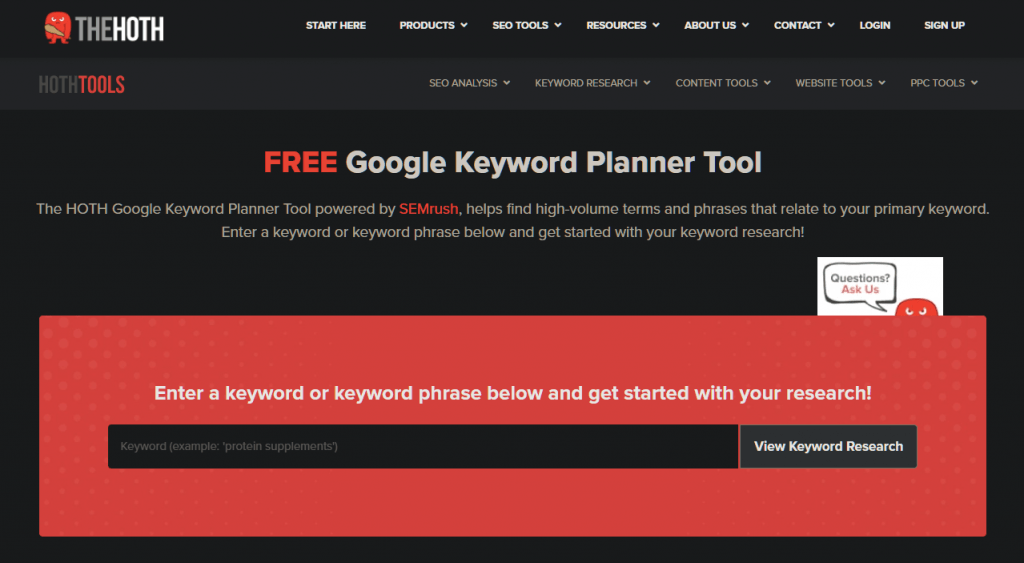Quick Links
How many backlinks do I need for my website?
This is the #1 question from new clients at The HOTH.
The only problem is it’s an impossible question, as there’s no one-size-fits-all answer for how many backlinks a website needs.
In fact, asking this question is on par with other impossible questions like, “How many licks does it take to get to the center of a Tootsie Pop?” and, “How much wood could a woodchuck chuck if a woodchuck could chuck wood?”
When most SEOs get this question, they all say the same thing:
“It depends.”
We think that’s pretty lame, and we’re sick of hearing it.
That’s why we’re going to do the impossible and attempt to answer this borderline rhetorical question.
Along the way, you’ll learn more about the current state of backlinks as a ranking factor and some up-to-date techniques for generating high-quality links that point to your homepage and content.
| What is a backlink?
Before we discuss the number of backlinks needed for ranking success, let’s define what a backlink is. Any link on an external site that ‘points back’ to one of your web pages is a backlink, hence the name. Think of it as a digital vote of confidence, especially if it comes from a website that already performs well in Google’s search results. |
Do Links Still Matter? Addressing Google’s Recent Comments
In September 2023, Google Analyst Gary Illyes downplayed the importance of backlinks, saying links were no longer a top 3 ranking factor.
This led some digital marketers to believe backlinks no longer move the SEO needle, which isn’t true.
Illyes acknowledged the importance of backlinks but disagreed with their top-tier status. His words should be taken with caution, as Google is notoriously secretive about its ranking algorithms to prevent manipulation.
Google aims to deliver the best search results, meaning they only want to rank trustworthy and authoritative sites. For this reason, they have a bit of a love/hate relationship with SEO.
They know that it’s necessary for businesses to improve their visibility on their engine, but their SEO advice seldom gets deeper than ‘make better content.’
Proof Backlinks Are Still The Real Deal
Take it from us: backlinks still matter in a very big way, and that’s not going to change anytime soon.
Perfect technical SEO (loading speed, mobile friendliness, URL structure, etc.) and flawless on-page factors (keyword usage, metadata optimization, high-quality content, etc.) will only get you so far.
Whenever we have a client that can’t outrank its competitors, links are almost always the reason why.
Since the websites occupying the top-ranking spots have more high-quality links than our clients’ sites, outranking them with basic SEO tactics is next to impossible.
As a result, we spend the most time ‘closing the competitive gap’ by building enough relevant links for our clients to level the playing field with their top competitors.
The fact remains that more backlinks equal better SERP rankings AND more organic traffic, which is why high-value links are so powerful (they’re literally working double duty for you).
To put our money where our mouth is, here’s hard evidence from one of our clients that backlinks and traffic go hand-in-hand:
As you can see by the line graphs, as the client’s backlinks started to increase, their organic traffic followed suit.
How Many Backlinks Do I Need to Rank?
As you can see, backlinks are crucial to ranking your content in the SERPS. So, what’s the magic number of backlinks you should aim for?
A well-established website typically has around 40-50 backlinks to its homepage, with individual pages varying from 0-100.
Too few backlinks and Google might not consider your site as relevant. However, too many can raise red flags about potentially manipulative practices.
The key is to focus on earning high-quality backlinks from reputable websites that have either topical or contextual relevance to your content.
In the section below, we’ll explore the factors affecting your ideal backlink count.
What Factors Determine How Many Backlinks I Need to Rank?
While links are still extremely important for Google SEO, they’re not the only ranking factor.
| What is a ranking factor?
A ranking factor is a criterion that search engines (like Google) use to assess and rank websites within their search results. These factors are the ingredients of search engine algorithms that determine a website’s relevance and authority for different search queries. It’s believed that Google uses over 200 ranking factors. |
As we said before, building more links bridges the competitive gap for our clients. However, without strong technical and on-page factors, reaching the top of the SERPs is impossible.
Google’s algorithm looks at technical factors like loading speed and interactivity, URL structure, broken links, and indexing errors.
On-page SEO factors, like keyword placement, content formatting, readability, and metadata optimization are also integral for high search rankings.
Here’s a look at the top SERP ranking factors:
Content quality
Let’s be clear: the #1 most important ranking factor is the quality and relevance of your content.
If you aren’t producing high-quality content that satisfies users’ search intent, your dreams of becoming the SEO GOAT will never come to fruition.
Moreover, the quality and relevance of your content are also extremely important to your target audience, and you should always produce content for them first and search engines second.
How does Google judge the quality of website content?
They use a team of human quality raters equipped with their Quality Rater Guidelines, which are represented by the acronym E-E-A-T – which stands for experience, expertise, authoritativeness, and trustworthiness.
Therefore, if you want Google to view your content as high-quality, you need to share first-hand experiences that demonstrate your expertise on a topic. An example would be citing a real-life case where you helped a client with your vast knowledge of your business’s area of expertise.
As far as content goes, you only have to worry about the first two E’s (experience and expertise).
Authoritativeness isn’t something you can build through content directly, as it has to do with the quality and relevance of the backlinks that point to your web pages.
Lastly, trustworthiness is accrued by consistently demonstrating experience, expertise, and authoritativeness in your content.
Content length
The length of your content is also a ranking factor, and there’s a sweet spot that you need to hit.
First, Google views web pages that contain less than approximately 1,000 words as thin content, and it doesn’t like to rank thin content because it’s viewed as unhelpful.
As a rule of thumb, try to include at least 700 – 1,000 words on each web page to ensure they aren’t flagged as thin content. However, you need to make sure that the words still provide valuable information, as just writing nonsense to inflate the word count won’t work.
If there are web pages that you just can’t add any more words to, try to merge them with a related page.
Since Google doesn’t like thin content, some SEOs have falsely assumed that more words are always better, which isn’t the case.
Google’s algorithms can identify when a page contains useless or irrelevant information. For example, a how-to guide on stringing guitars doesn’t need to include a 400-word section on the history of the guitar.
Sticking to the 1,000 – 2,000 word range for blogs is a good range to stick with for most topics. That’s not to say that you can’t write longer guides, just that every piece of information must be relevant and valuable.
SSL certificate
Security is a priority for Google, as they don’t want to direct users to unsecure websites where they might have sensitive personal or financial information stolen.
That’s why they only rank websites that contain SSL certificates, which provide a secure web browsing experience through HTTPS. All communications are encrypted using the SSL/TLS protocol, making things like e-commerce transactions safe.
The good news is it’s extremely easy to get an SSL certificate for free.
Passing the Core Web Vitals test
Internet users have no patience for websites that don’t load within a fraction of a second. Google is aware of this, which is why they developed the Core Web Vitals test.
It examines a website’s speed for not only loading but also interactivity.
To learn more, you can check out our guide on passing the Core Web Vitals test.
Keyword usage
At the most basic level, search engines match user queries (keywords) with websites that contain exact matches and related keywords.
An example would be Google ranking a piece of content called ‘How to String Guitars’ in the #1 spot for the query ‘how to string guitars.’
Make sense?
Despite all the advancements in the SEO world, proper keyword placement still matters. Here’s where to place your target keywords:
- In your title tag and H1 header
- In the first 100 words of the content
- In image alt tags
- Organically, throughout the piece
- In the metadata
You can use our free keyword planner tool to uncover popular keywords related to your business, which is the best way to find topic ideas.
URL and page architecture
If Google’s algorithm can make heads or tails out of your site structure, your content likely won’t rank very well.
Google prefers sites that use logical, ‘flat’ designs for their site architecture, where every page is only one or two clicks away from the homepage.
Deep site architecture uses long link chains that lead to inner pages (which are hard for both Google and users to find).
Whenever you’re designing your site and URL structure, follow the K.I.S.S. method and keep it super simple.
Internal and external links
Whenever you make a claim in your content, you should always back it up with evidence via an external link.
The websites you choose matter here, too, as you want to link out to reputable sources.
TLDs (top-level domains) ending in .gov, .edu, and .org are always safe best, as are academic journals and studies.
Also, don’t forget to include internal links in your content. This serves a dual purpose, as it makes your content easier for Google to index – and internal links provide resources for further reading that will keep users engaged in your content loop (and will boost your dwell times).
Drop anchor! Achieving the proper anchor text ratio
Besides the links themselves, the anchor text you choose for each link is also incredibly important.
Anchor text is the visible, clickable text within a hyperlink. It typically appears in a different color (often blue, but we prefer red) and is underlined, signaling to users that it’s a link.
Here are the most important things you need to know about anchor text:
✔️Relevance: The anchor text should accurately describe what the linked page is about. This aligns with user expectations and helps search engines understand the target page’s content.
✔️Balanced anchor text ratio: Aim for 2-5 words in your anchor text. Briefer phrases are more readable and less likely to appear spammy.
✔️Natural language: Avoid overly optimized, keyword-stuffed anchor text. Use conversational language that flows organically within the text.
✔️Variety: Change up your anchor text types to create a more natural backlink profile (more on that below).
Anchor text types
There are a few different types of anchor text that you can use, and it’s imperative to use a mix of them all.
Google doesn’t like to see lots of exact-match anchors, which contain the keyword you’re targeting and nothing else. To Google, this is an attempt on the site owner’s part to manipulate the search rankings, which is why the need for an anchor text ratio arose in the first place.
| Anchor Text Type | Description | Example |
| Branded | Using your brand name or a variation | “Ahrefs”, “Visit the Ahrefs blog” |
| Exact-match | The precise keyword you’re targeting | “link building strategies” |
| Partial-match | Includes your target keyword along with variations | “learn about link building techniques” |
| Generic | Common phrases with no specific keywords | “click here”, “this website” |
| Naked URL | The page’s URL is displayed as the link | https://www.semrush.com/blog |
| Image Alt Text | Descriptive text for an image used as a link | “Chart showing SEO ranking factors” (for an image linking to a page about ranking factors) |
| What is the ideal anchor text ratio?
For your backlink profile to achieve its maximum impact, it needs to feature a favorable anchor text ratio. There’s no single “perfect” ratio, but aiming for diversity and naturalness is key. Basically, you’re just trying to avoid your links getting flagged as spam by Google. Here’s a general guideline:
|
Competition in your niche
Remember, you won’t be the only one optimizing your site for better performance on Google’s SERPs. Your competitors will also engage in SEO, so you always need to keep an eye on your top competitors.
In particular, regularly analyzing their content and backlink profiles can provide valuable insights to boost your own strategies.
You can use our free SEO audit and backlink checker tools to analyze your competitors. Pay attention to the keywords they use, where they get their backlinks from, and how much traffic/engagement they’re getting.
The Classic Debate: Quantity vs. Quality
SEOs are always fiercely debating whether backlink quality or quantity matters most.
Some swear that only the most reputable, highest-quality backlinks are worth pursuing, while others claim to find success by building as many links as possible.
Which side of the issue is true?
We hate to be boring, but the truth is that both quantity and quality are equally important to your link profile.
Let’s clarify that a bit further.
When quantity matters
In terms of quantity, it’s NEVER worth pursuing low-grade backlinks from garbage websites that provide no value to users.
These links scream spam to Google, and they’ll only hurt your SERP rankings.
However, when you’re trying to bridge a significant link gap between you and a competitor (where you have dozens of links and they have hundreds or thousands), sometimes links with average domain authority (scores 40 to 50) are exactly what you need.
These average links are still from real websites that provide services to users, so there’s no worry about them getting flagged as spam.
Moreover, they’ll provide you with the volume of links you need to catch up to the competition.
In other words, beggars can’t be choosers when you’re far behind in the backlink race.
When quality matters
That’s not to say that you shouldn’t shoot for the stars and target high-value backlinks (DA scores 60 and above) at the same time, as you definitely should.
Conversely, if you’re practically on par with the number of links a competitor has, then going for high-quality links is the name of the game.
Ultimately, it depends on what you’re trying to achieve. If you’re far behind, quantity can beat quality – but if you’re neck-and-neck, quality reigns supreme.
These factors are all imperative for SEO success, so you shouldn’t neglect any of them during your search campaign.
How Do You Get Backlinks?
By now, you should have a specific number of backlinks you need to build. To reiterate what we’ve covered so far:
Analyze your competitor’s backlinks to gauge the gap between your link profiles. If the gap is significant, initially focus on building a larger number of links, even if some are of lower quality.
This helps establish a baseline. As you gain more links, shift your strategy to acquiring high-value links.
For brand-new websites, aim for 50 links to your homepage and around 100 for your most important pages.
Now that we’ve addressed the core question let’s explore another important aspect:
How do you build links that point back to your content?
Here’s a look at some of the most effective ways to acquire backlinks.
Targeted link outreach
Conducting outreach is necessary for just about any backlink technique, and it’s become more nuanced in recent years.
In the past, SEOs found success using generic outreach templates that contained simple requests for guest articles, link insertions, and fixing broken links.
The only problem is this technique worked a little too well.
Once it caught on, it became the norm (and still is) for website owners to receive hundreds of generic outreach emails every day.
Currently, the link outreach game is about standing out from the crowd while developing long-lasting relationships that lead to multiple links down the line.
It’s crucial to shift your mindset from targeting one link at a time to forging long-term link partnerships with related websites in your field.
Also, divorce the link outreach process from one particular tactic, such as guest posting.
When done properly, your outreach can lead to a lot more than guest blogs (although those are pretty sweet, too).
An outreach example
As an example scenario, let’s say that your website sells fitness products.
In that case, you’d benefit from forming link partnerships with noncompetitors in your field – meaning you share a target audience but don’t compete for the same business.
Examples include fitness news websites, fitness forums, and nutrition blogs – just to name a few.
Instead of sending one-and-done outreach emails, you start interacting with these sites in a far more personal way. Your goal is to form a relationship instead of securing one measly link placement, so you should interact with their social media, ask interesting questions, and share their content.
If you play your cards right, you’ll form a partnership that leads to guest posts, link insertions, and article syndications.
Article syndication
Speaking of syndication, you can start publishing your articles on other websites to gain more exposure and accrue links.
Relationship building is a key component here, too, as you’ll need an existing network of relevant websites to publish your articles.
If you don’t have any connections yet, try searching on Google for things like:
- “Originally published on” (niche keyword)
- “Syndicated from” (niche keyword)
- “Originally appeared on” (niche keyword)
These search operators will help you find websites in your field that syndicate posts and it’s worth trying to build relationships with them.
You can also use our free backlink checker tool to analyze your competitor’s links to see if they’re syndicated anywhere that you aren’t.
Press releases
Press releases (as long as they don’t mention time-sensitive events) are another great way to get the word out about your brand and obtain links.
This is where it pays off to have relationships with news outlets in your niche, as you’ll be able to circulate your press releases to them for some easy links.
Why can’t you mention time-sensitive events?
You shouldn’t because this type of press release exists to provide backlinks to your site. If you mention a time-sensitive event (like an upcoming conference), you’ll have to remove the press release as soon as it happens.
That’s why you should stick to things like launching new products, hiring new executives, and interesting developments in your business (like adding a new department).
Here’s an example of a press release we created and distributed through Cision for backlinks and better online visibility:
To further your education, here are some more reliable ways to build backlinks from relevant websites.
Broken backlinks
Link rot is a real struggle that every website faces.
It’s the tendency for hyperlinks to no longer point to their original web page or server after long periods of time. There are numerous causes for this, the most common of which is when a site migrates to a new CMS or changes its link structure.
As a result, virtually every website will have broken links, and they present a unique link-building opportunity.
Say that you come across a broken link on a website that covers a topic you already have a blog post about.
In that case, you could reach out to the site owner, notify them of the broken link, and offer your content as a quick replacement.
Since broken links hurt a website’s user experience, site owners have a very real incentive to fix them by adding your link.
How do you find broken backlinks to target?
One of the easiest and most reliable ways is to use Ahrefs, but you can also use web crawlers like Screaming Frog.
If you have an Ahrefs account, navigate to the Site Explorer tool. From there, enter the URL of the website that you want to check for broken links.
Under Backlink profile, select the Broken Backlinks report.
Voila, you now have a complete list of the website’s broken links that you can analyze for backlink opportunities. Try to find broken links that relate to your business’s content. If you don’t already have a viable replacement piece, you can always create one.
Start Building the Right Number of Links Today
Well, wasn’t that a much better answer than simply saying, “It depends?”
Now, you have an accurate approximation of how many links you need to build to achieve your ranking goals, and you know the best ways to build them.
This is only the first step in your journey to becoming the SERP master, so stay tuned to our blog for more practical advice.
If you need help building the right number of links for your website, don’t wait to check out our Link Outreach and Link Insertion services.

















Great Article Guys! Just Ordered some guest posts.
So Google is making it hard every day, so to rank a keyword which has difficulty 29, we need 32 backlinks but this tool doesn’t tell us that what should be quality of these backlinks, may be only backlink from a guest post can be enough as compared to 32 links.
Get 32 in-content backlinks, wait a few weeks and you’ll see if they were good enough 🙂
This came at the right time… Thanks a bunch
Are there any free tools that you know of for figuring out this same information?
You can check semrush free plan
Obtaining backlinks nowadays is a great task as requires a lot of effort and time. Also, once you obtain a backlink it takes time for your site’s ranking to improve in search results. Thanks, Hoth team for writing such a useful article 🙂
I like the tool that tells you about how many backlink it takes for the site to rank on top 10. Short and informative article you have there.
I think guest post back link still does help a lot for better ranking on search engine. Ok, now one point to be noted here, back link from quality guest can help, not the junk one. I am using this technique to grow my site.
Great post! It is always interesting I think to check in Ahrefs like you mention to see the sheer difference in terms of how many backlinks and unique RD different websites have on any given SERP.
Great post! Building backlinks are that one thing most of dread to do. It just seems tougher to do when you’re a small business without the brand recognition the bigger guys get. Info like this definitely helps!
Thanks for the post. I want to start buying some myself.
If you have any questions about it simply submit a ticket with our support department.
What impact does the SERP layout have on the overall value of a page one ranking in the first place?
I’ve seen data from G that this current layout only has about 20% of all clicks on the page occurring in organic listings. Meaning that 80% of search traffic has found a solution to their query before getting that far down the page.
How does that factor into what decisions you make on traffic?
Every query is different and it’s going to be hard to make a blanket statement, but Ahrefs does use clickstream data to factor that in, so I like to look at their traffic estimates.
Re: The layout, I’m a big fan of getting out of the tools and really searching the keywords in Google to see what’s coming up. The results will often surprise you (local map packs ranking, youtube videos, rich snippets, different search intent types of articles). Then mimic that content to gobble up as much traffic.
Either way, ranking high is going to be better than ranking low (or not trying at all), and there is so much opportunity with SEO.
As a side note, ads are growing bigger and look more and more like organic search results. We can help with that too!
1 good link may be worth more than 10,000 crappy links but no one knows which is that 1 good link.
In-content links on high authority domains are what you’re looking for.
Great post! Guest posts are the best backlinks, but your price is a little expensive, I will consider your service.
Thanks for the comment!
Good Info! Obtaining solid high-quality links from relevant industry sites takes a lot of time, energy and effort. There is no short cut to improving your search results.
Ahrefs Keyword Explorer is a paid tool…what other tools will provide the same or similar results?
short and to the point. Thanks HOTHers!
I’m going to be buying some incontent links soon. Just saving up for it. Thanks for the info. Very handy. I don’t have Ahref, would love it if you can help in getting some data.
Just book a meeting with us here and we can run reports for you!
Do you really have to do guest posts? Is there another way?
Yes, there are lots of ways to get links! With that said, in-content links on good sites are really what you want to drive rankings and guest posts are one of the most scalable and effective ways of getting them.
I’m having a hard time right now getting on first page of Google, and this article is really helpful.
Though one thing you missed which I would like to add is **PATIENCE & Consistency**
It’s been a month I launched website and still 0 visitors a day lol.
One website I launched last year was in low competitive niche, so I got 50 visitors a day after around 2 months, and ranked for some good keywords on the first page.
Yes 100% – We wrote an article about this here: https://www.thehoth.com/blog/why-you-need-the-gym-of-seo/
Ahref show 30 link need…is it 30 link every month we need to build to rank in 1st page?
It would be 30 total, but keep in mind top rankings generally continue to receive links over time, so this number may change as well in the future.
Thanks, I appreciate your efforts to show us how many back links to be first on google..
This is great insight of how many links needed, my travel blog’s DA is stuck at 25 for long , the target traffic is from India, I have few good backlinks to my domain, what should I do more?
Your Domain Authority will increase by getting more links.
When I’m looking at the backlinks to build in other to win, I try to look at the page level and the velocity of the link the top 5 received because I want the link to look natural, I don’t want to be too pushy.
And for the number of link you need to rank, there’s no actual figure but for Google to consider you as a contender in the top ten, you need to get around the same number of links they have.
Plug your keyword into any link explorer and find the number of root domains that links to the page, remember the link should be on a page level.
Do this for all top 10 result to find the number of root domains and calculate the average number of root domains. That gives you the number of root domains you need.
how to get backlink from 0 backlink in a site
Thanks for this useful information.How to get free Df Backlinks. Request to guide . I am new in this . How get traffic on a particular keyword in which difficult to get traffic.
haha right when I first clicked on the link to this article, I answered the question to myself “It depends”… then immediately saw that at the top of the page while it loaded.
But from my experience, domain authority is a really huge factor that gets overlooked very often when it comes to ranking. Because of that, I’ve stayed away from a lot of the ambitious keywords I’ve wanted to rank until I build much more authority myself.
Thank you very much Clayton for this complete guide about how to create the first 100 backlinks. I totally agree with you, quality backlinks are the gold key for ranking high, unfortunately it is not so easy to get them so my motto is: “whatever link (not spammy) is just better than no link”.
nice article I have one doubt which basis google will search results top position websites for one keyword. which one high priority in search result appears to tell me.
thanks for this great post. All post of Thehoth is awesome. Learn good things from this article.
Great aticle. I think getting backlink from a higher authority domain makes content much more trustworthy than multiple backlinks from less or no authority domains.
Great Read.
Thank you very much Clayton. The first 100 backlinks are probably the hardest given that in time you would drop some along the way. But reaching 100 quality links.. The quality of the backlink would be more important than quantity in today’s SEO world wouldn’t you say?
Thankyou for this post very interested as im constantly trying to build my backlinks quality is the key. The Hoth has really helped me over the last few months with my SEO.
Appreciate all the efforts that you have taken to do such a detailed post! Thanks for sharing.
Hi Clayton Johnson, I’m not the first to tell you this, but you really helped a lot of people putting all this information down. Thanks so much!
Nıce
How can I get excellent backlinks for my website:
https://renaissance-translations.com/english-hindi-translation-services-in-the-uk/
How can I get excellent backlinks for my website?!
Hit up our team, they’ll be happy to help: https://www.thehoth.com/meet/
Good Information!
It takes a lot of time, effort, and energy to acquire reliable, high-quality links from sites that are relevant to the business.
Good job and thanks for sharing
This is awesome and i appreciate the post. Really educative and i really wish to know how to get backlinks. Can you help?
Hey Rachel, I completely agree with you. One good backlinks worth 10000 cheap link. Also, content plays a major role in ranking and i try to create long form and guest post in niche sites to acquire high quality link that works for me.
I read this article very carefully and backlinks are one of the most important ranking factors no doubt …. but what about the age of the website? Do you think it is still important?
Hey Michael,
Not a hard and fast rule, but I’d say the longer a website has been around, the more authority it’ll have just via simple ranking factors. That said, things like DA and DR, traffic and general reach will have a more profound impact on the link’s value. Hope this helps.
Thank you Rachel
Thanks for the post. I want to discuss about some for our website before buying.
You can schedule a call with one of our experts here to dive a bit deeper: http://www.thehoth.com/meet
I’m going to be buying some incontent links soon. Just saving up for it. Thanks for the info. Very handy. I don’t have Ahref, would love it if you can help in getting some data
Hey, the content is awesome, and it’s very informative. Keep up the good work
Is this still applicable in all niches and can I do it for my photobooth rental company?
For me, finding the best numbers is by analyzing the Google Search Results and making a roadmap accordingly. I’ll clear this up with an example.
Suppose I search for “SEO Services Phoenix.”. I find different websites ranking in the Top 10 Spots of Google. I’ll use Ahrefs’ Free Backlink Checker to count the referring domains of the websites. The average number of referring domains these websites are getting is around 350-430. It means I need to make backlinks on at least 500-520 websites to outrank these websites and earn the top 10 positions. That’s how I calculate the number of links I need to make to rank a particular keyword, but here is one more thing.
I can’t make 500 links in one month on a new website. This thing confuses the newbies. You can’t make 500 links in one month, but you need to wait for some months to pass. I commonly start building backlinks after 40-50 days when my content gets uploaded. I prefer building 5-6 links in the 1st month, 7-9 links in the 2nd month, and 10-12 links in the 3rd month. That’s how my speed continues. After 7 months, I start building 15 links monthly. I’ll reach the 500 referring domains in at least 1.5 or 2 years.
That’s my ranking strategy, but you’ve also shared some deep insights with the audience. Overall, your post on discovering the number of backlinks is good. Please keep up the hard work, Rachel Hernandez. I have 8 years of experience in SEO. I liked your article, which was the reason to share some of my knowledge with your audience. Thanks!
Impressive